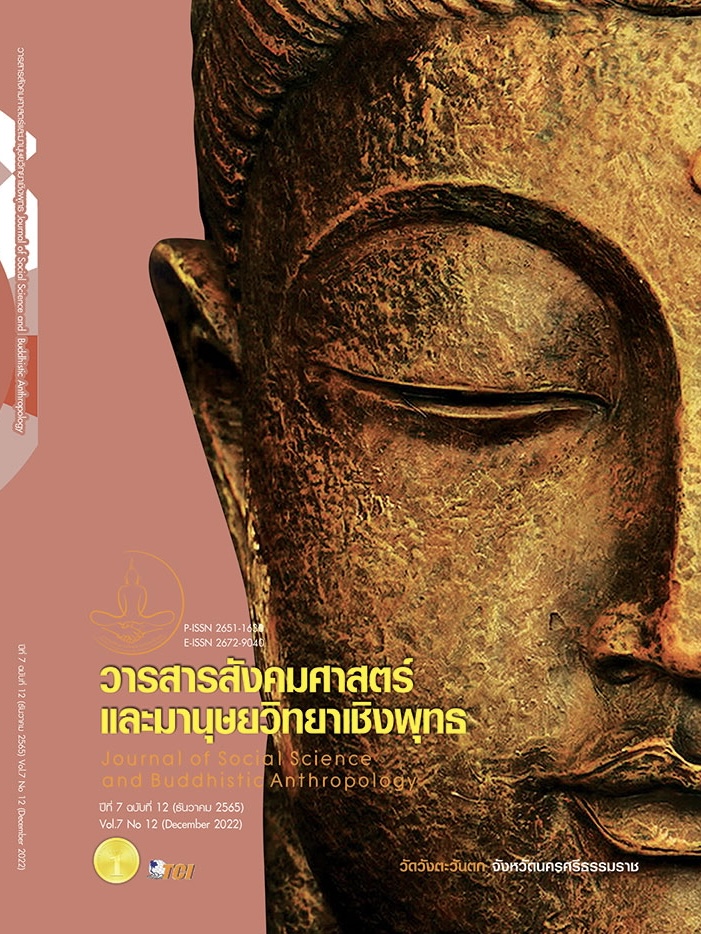INFLUENCE OF FACTORS IN ENTERPRISE NETWORK INTEGRATION ON SUSTAINABILITY OF HEALTH TOURISM IN PRACHINBURI PROVINCE
Keywords:
Health Tourism, Enterprises Networking of Tourism Industry, Sustainable TourismAbstract
The objectives of this research paper were to 1) study the potential of health tourism enterprise associations of entrepreneurs in Prachinburi Province 2) study the potential of health tourism enterprise associations of stakeholders in Prachinburi Province 3) study Potential in the management of the group of health tourism enterprises in Prachinburi Province. This research is quantitative research. There was a sample group. 320 small, medium and large health tourism entrepreneurs in Prachinburi Province, using the questionnaire as a tool to collect data. Descriptive statistics were analyzed by finding the mean, frequency, percentage, standard deviation and variance. and inferential statistical analysis by exploratory component analysis. Descriptive statistics were analyzed by finding the mean, frequency, percentage, standard deviation and variance. and inferential statistical analysis by Exploratory Factor Analysis (EFA) to analyze the exploratory component to find the composition of 3 independent variables, namely, the potential of joining the tourism enterprise network of 1) entrepreneurs 2) Stakeholders and 3) Management. And the researcher tested the influence of the variables according to the regression model equations. By analyzing multiple regression (Multiple Regression Analysis). Entrepreneurs have a level of opinion about the potential of entrepreneurs' health tourism enterprise integration. stakeholders and the management aspect are at a high level in every aspect The mean were 3.83, 3.69 and 3.71, respectively. The test results found that Potential of entrepreneurs' health tourism enterprise integration Potential of Stakeholder Health Tourism Enterprises and potential of aggregation of tourism enterprise networks in management Influencing the sustainability of the health tourism enterprise network integration of Prachinburi Province statistically significant
References
กรมการท่องเที่ยว. (2561). คู่มือการพัฒนาการท่องเที่ยวเชิงสุขภาพของจังหวัดปราจีนบุรี. กรุงเทพมหานคร: คอนซัลแทนท์ ออฟ เทคโนโลยี.
กระทรวงการท่องเที่ยวและกีฬา. (2562). อุตสาหกรรมการท่องเที่ยวกลุ่มรายได้ดีและการท่องเที่ยวเชิงสุขภาพ. กรุงเทพมหานคร: สถาบันทรัพย์สินทางปัญญาแห่งจุฬาลงกรณ์มหาวิทยาลัย.
กระทรวงสาธารณสุข. (2559). แผนแม่บทแห่งชาติว่าด้วยการพัฒนาสมุนไพรไทยฉบับที่ 1 พ.ศ. 2560 - 2564. นนทบุรี: ทีเอสอินเตอร์พริ้นท์.
กานดา ธีรานนท์. (2561). การท่องเที่ยวเชิงสุขภาพของประเทศไทย : สถานการณ์และศักยภาพ ทางการแข่งขันในภูมิภาคอาเซียน. วารสารวิชาการมหาวิทยาลัยฟาร์อิสเทอร์น, 12(supplement), 99-109.
ดนัย จันทร์เจ้าฉาย. (2556). ไทยกับการท่องเที่ยวเชิงสุขภาพ. สัมมามาร์เก็ตติ้ง. Marketeer, 2556 (159). เรียกใช้เมื่อ 30 กรกฎาคม 2563 จาก http://marketeer.co.th/2014/09/ดนัย-จันทร์เจ้าฉาย
ไทยรัฐออนไลน์. (2562). ความสำเร็จจากการเข้ารวมกลุ่มของผู้ประกอบการในรูปแบบ "คลัสเตอร์" โดย สสว. เรียกใช้เมื่อ 25 กรกฎาคม 2563 จาก https://www.thairath.co.th /news/business/1632508
วิทยา จันทะวงศ์ศรี. (2557). ปัจจัยที่มีผลต่อความสำเร็จของกลุ่มวิสาหกิจชุมชน อำเภอกันทรวิชัย จังหวัดมหาสารคาม. ใน วิทยานิพนธ์เศรษฐศาสตรมหาบัณฑิต สาขาเศรษฐศาสตร์ธุรกิจ. มหาวิทยาลัยขอนแก่น.
วุฒิชาติ สุนทรสมัย. (2560). การพัฒนาการรวมกลุ่มแบบเครือข่ายวิสาหกิจด้านการท่องเที่ยว: แนวคิดและการประยุกต์. กรุงเทพมหานคร: ประจักษ์สิน.
สำนักงานการท่องเที่ยวและกีฬาจังหวัดปราจีนบุรี. (2560). สถิตินักท่องเที่ยวของจังหวัดปราจีนบุรี. เรียกใช้เมื่อ 24 กุมภาพันธ์ 2563 จาก https://prachinburi.mots.go.th
อุษณีย์ ผาสุข และคณะ. (2561). แนวทางการพัฒนาเมืองสมุนไพรในจังหวัดปราจีนบุรี เพื่อดึงดูดตลาดนักท่องเที่ยวเชิงสุขภาพ. วารสารวิชาการมหาวิทยาลัยธนบุรี, 12(พิเศษ), 150-162.
เอกกมล อ่อนศรี. (2544). ปัจจัยที่มีผลต่อการพัฒนาความเข้มแข็งของเครือข่ายองค์กรชุมชน. ใน วิทยานิพนธ์วิทยาศาสตร์มหาบัณฑิต สาขาวิทยาศาสตร์. สถาบันบัณฑิตพัฒนบริหารศาสตร์.
Cohen, J. M. & Uphoff, N. T. (1981). Rural Development Participation: Concept and Measure For Project Design Implementation and Evaluation: Rural Development Committee Center for international Studies. New York: Cornell University Press.
Global Spa Summitt. (2012). RESEARCH REPORT: GLOBAL SPA SUMMIT 2011. Wellness Tourism and Medical Tourism: Where Do Spas Fit? Retrieved February 20, 2020, from https://zhort.link/D4f
Jackson, J. (2004). Developing regional tourism in China: The potential for activating business clusters in a socialist market economy. In Melbourne Office of the Vice – Chancellor. La Trobe University.
Kammeier, H. D. (2001). Sustainable City Symposium. Bangkok: หจก.เชียงใหม่โรงพิมพ์แสงศิลป์.
Kieanwatana, K. (2018). สถานการณ์และแนวโน้มการท่องเที่ยวเชิงสุขภาพโลกและประเทศไทย. Journal of Cultural Approach, 19(35), 77-87.
Marketeer. (2017). Wellness Tourism โอกาสของธุรกิจท่องเที่ยว. Retrieved February 15, 2020, from https://marketeer.co.th/archives/132134
Yamane, T. (1970). Statistic: an Introductory Analysis. (2nd ed). New York : Harper & Row.
Downloads
Published
How to Cite
Issue
Section
License
Copyright (c) 2022 Journal of Social Science and Buddhistic Anthropology

This work is licensed under a Creative Commons Attribution-NonCommercial-NoDerivatives 4.0 International License.








